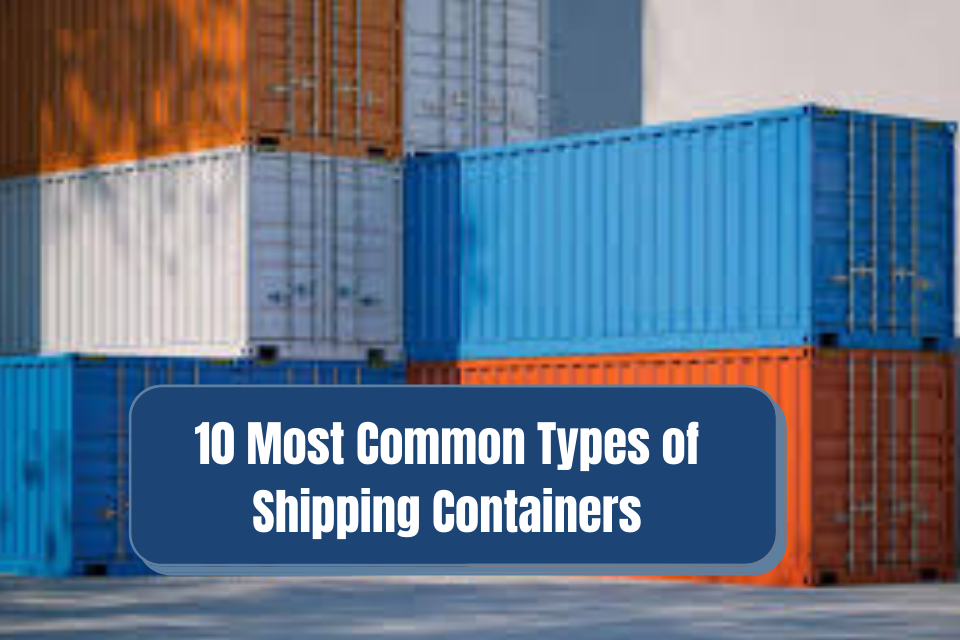Shipping containers plays the most vital part in delivering goods from one region to different parts of the world. Whether it is trade, shipping industry, or transportation work, none of it will be possible without shipping containers.
Numerous types of shipping containers are used to store different kinds of goods depending on the structure or requirement of the material that is being transported.
The primary purpose of using shipping containers is to ensure or guarantee the safety of the products, as more than 90% of the world’s cargo is carried by ships. The containers vary in different structures, shapes, dimensions based on the product they are meant to carry and their purpose.
Here are the 10 most common and generally used shipping containers:
1. General Purpose Containers
The general purpose containers are the most commonly used category of containers. These are also known as Dry Containers. They are used to ship dry products, and they are fully enclosed from all sides, making them weatherproof. These containers carry standard types of cargo.
They come in various sizes ranging from 40ft, 20ft, and 10ft. Some dry containers might have flexitank or linear bags to carry certain liquids or dry bulk cargo.
2. Flat Rack Containers
Flat rack containers are ideal for carrying goods like heavy machinery, vehicles, building materials, etc. These containers have collapsible sidewalls, which can be folded to store cargo in a more accessible and efficient way. After loading the shipment, the sidewalls can be unfolded, making it a secure way to transport cargo.
3. Open Top Containers
As the name suggests, the roof or the top of the container is entirely removable. This feature makes over-height products that cannot be loaded traditionally from the front door easy to load. Likes of the product include tall machinery and finished products that are tall in nature and can be loaded from cranes or rail bridges only.
4. Double Door Containers
These containers have doors on both ends. It is also called a Tunnel container. Having doors on both ends makes them very accessible for quick loading and unloading of products. It also allows putting slightly wider products. Both the doors have a similar locking scheme and are weatherproof, ensuring the safety of the goods.
5. One Side Containers
One side containers are very similar to the general-purpose containers. The only noticeable difference between them that sets them apart is that the doors can open entirely on the sides. Due to this capability, it creates a much wider space to load and unload stuff. This container is ideal for materials that cannot be loaded through the front doors. One side container is generally available in two sizes, 20’ and 40’.
6. ISO Reefer Containers
The ISO reefer is an exceptional kind of container. These containers are generally used for storing and shipping temperature-sensitive products or materials. The most common examples of the products can be edibles like fruits, vegetables, meat, etc. Keeping them at a specific temperature is necessary; otherwise, they will rot before reaching their destination.
These containers are powered by an external power source to maintain the specific internal temperature inside the container.
7. Insulated Containers
Similar to the last container mentioned above, this comes under the special category of containers. The insulated containers share a lot in common with the ISO Reefer container.
The only difference is that the thermal container has a regulated temperature that can cope with high temperatures. They are attached to a mechanical compressor to heat or cool the insides of the container. They carry items that are easily affected by temperature, like blood, organs, food materials, etc.
8. Tank Containers
The design of a Tank container is very different from our traditional containers. These containers are designed to carry liquid or fluid materials. They are made up of strong steel and anti-corrosive materials.
But there is a condition with them, and these tanks must be 80% filled to prevent surging of liquids inside them and should not be filled more than 95% to allow sufficient room for thermal expansion.
9. Half Height Containers
They are most commonly used in transporting bulk cargo that is supposed to be extremely heavy and dense in nature. Goods such as coal and stones are the ideal stuff for half-height containers. The most area where these containers are utilized is the Mining industry. They are designed in a way so that they have a low center of gravity compared to our tall containers for better handling. These are very robust and very easy to load and unload goods.
10. Car Carriers
These containers are specially designed for transporting newly manufactured cars from one place to another. Most of the vehicles we use are imported, and these containers help them reach their destination safely. These containers are equipped with collapsible sides that allow the car to get loaded in the container.
Keep Reading:
Different Types of Shipping You Probably Didn’t Know About
7 Different Types of Cargo Transported Through Shipping
Conclusion
Mentioned above are the most common types of containers that are used in transporting goods that we use in our daily lives. Each container is made with a specific purpose to fulfill and follows a different trait.
If you’re looking to rent shipping containers, we’re here to help. At Tassgroup, we offer high-quality 40ft and 20ft storage and high cube containers at affordable and flexible lease options. Feel free to contact us to know more about how we can help you!



